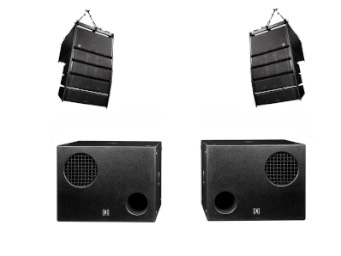
Church Systems - should they be Mono or Stereo?
Churches have migrated from the bullhorn and soapbox to fairly large complex sound systems. Most church buildings today are not designed for sound, so even the smallest church building needs a good sound system. Why do churches go through at least 2 sound systems before they get one that really works? The common errors in purchasing sound equipment, is that the music stores don't usually have the church's best interest at heart. Do they have the necessary skills to determine the church's needs? Do you think of speech reproduction first? or Do you design for music reinforcement? Most churches end up with a sound system that doesn't meet their needs.
All churches need 2 sound systems (a mono system for speech and a stereo system for music)
The most economical way to achieve that is a dual function sound system. What is a dual function system? It is a Left/Center/Right configuration. The L/R is used during the worship portion of the service and the Cluster (center) is used for speech reinforcement. You can get great sound for both your pastor and the musicians by carefully planning, and understanding the dynamics of a dual function system.
The criteria for those systems: even and full bandwidth coverage to every seat in the venue
If your facility is 5000 seats or less you do not need multiple speaker layers on delays
You can achieve full coverage with the latest LINE ARRAY technology (a vertical stack of multiple speakers). In fact most concerts that you go to today use the same technology but run it in single channel (mono) mode. (The area of coverage is too big to have stereo sound)
An oversight that I often witness in sound system design, is the failure by the designer to differentiate between speech and music. The assumption that a spacious sounding music system will reproduce speech in an acceptable manner can be an expensive one. The quality of music reproduction, is very subjective. Like art, there is no absolute criteria for good or bad. Speech on the other hand, can be judged on the basis of intelligibility. It is possible to assign a quality score to a sound system's ability to reproduce speech.
The criteria for proper reproduction of speech and music are almost the opposite.
A simple example helps illustrate the point. A choir in a reverberant space sounds very pleasing to a listener during a musical performance. Ask the same choir to read a sermon to the congregation and there will be total confusion. The timing inconsistencies and pitch variations that make the musical performance a pleasing experience can only confuse speech. Placing too many loudspeakers, with the inherent timing differences to various listener positions can have the same effect. The implication is that for a system to excel at music and speech, it should be a multi-channel system in design.
Criteria for Optimum Speech Reproduction
Single point of origin (center speaker system)
No reflections within 10 ms
No high-level late reflections (>50 ms)
Positive direct/reverberant ratio (Reflective sound often hinders vocal intelligibility)
Criteria for Optimum Music Reproduction
Several points of origin desirable (at least a two point of origin speaker system. L/R stereo)
Comb filtering can change the tonal character of the direct sound field in a pleasing way
Negative direct/reverberant ratio a plus for many types (organ, choral, symphony)
Reflected sound desirable

